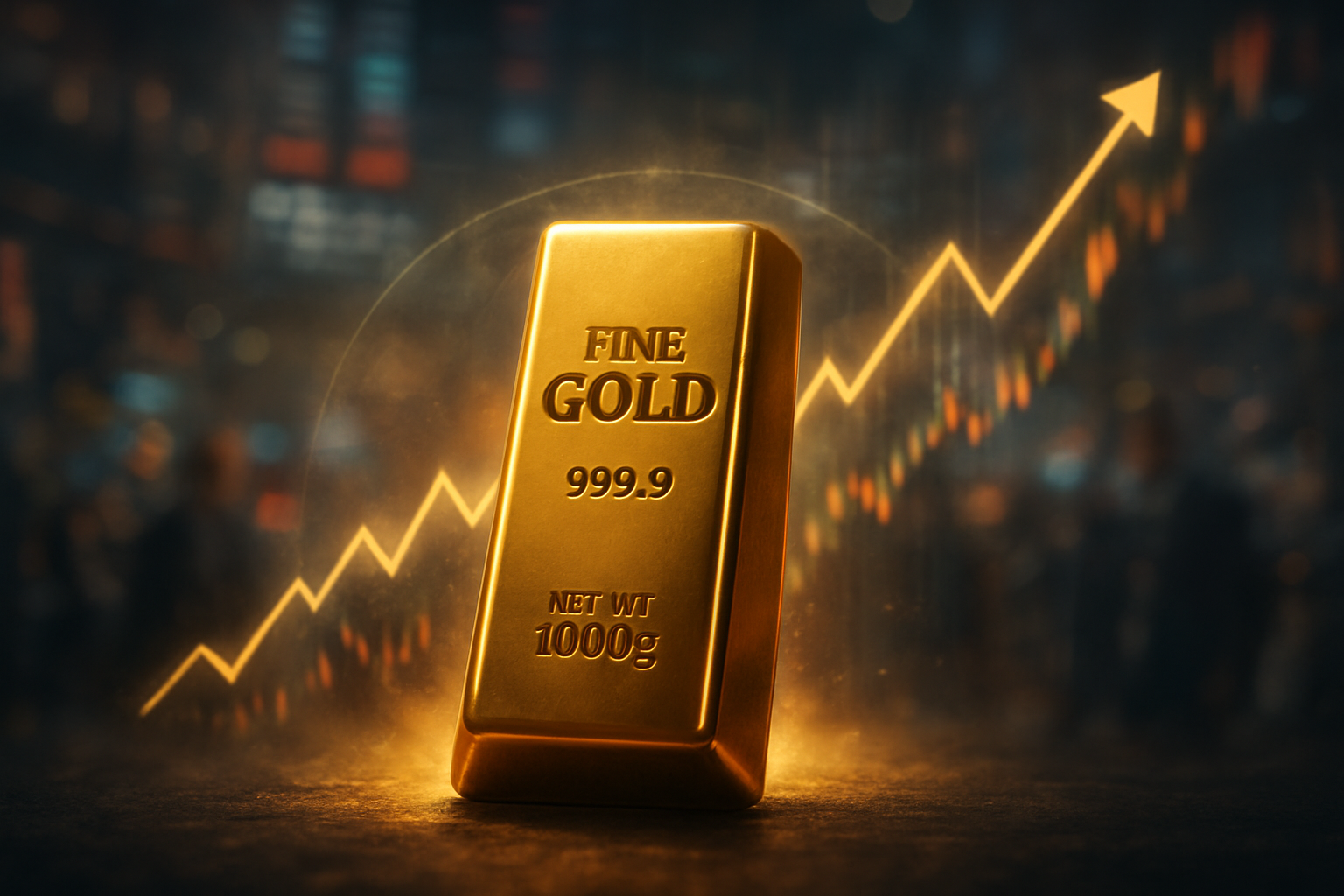
In an unprecedented display of market dynamics, the price of gold per Troy Ounce surged to an all-time high of $4,378 in mid-October 2025, marking a significant milestone in the precious metal's storied history. This monumental climb, representing nearly a 60% year-to-date increase, has sent ripples across global financial markets, with investors and consumers alike re-evaluating their strategies in the face of persistent economic uncertainties. The surge is a clear indicator of gold's reinforced role as a safe-haven asset, attracting capital amidst concerns over U.S. regional bank credit stress, a depreciating U.S. dollar, and speculation surrounding potential Federal Reserve rate adjustments.
The immediate implications are profound. For the broader market, gold's ascent underscores a prevailing sentiment of caution and a flight to tangible assets. For investors, particularly those who held gold prior to this rally, the record high presented a substantial opportunity for wealth realization. This phenomenon is vividly illustrated by reports from local businesses like Glitter Bug Gold Buyers, an Orange County-based service, which has announced "record-breaking growth in 2025," experiencing a staggering 200% increase in customer traffic. This surge in activity highlights a consumer-driven response to capitalize on historically high prices, transforming old jewelry and coins into immediate liquidity.
The Unfolding Narrative: Gold's Historic Rally and Market Response
The journey to $4,378 per Troy Ounce has been a culmination of several converging economic and geopolitical factors throughout 2025. The initial impetus for gold's rally began early in the year, fueled by escalating global economic uncertainties, persistent inflationary pressures, and a general erosion of confidence in traditional financial instruments. As credit stress within U.S. regional banks became more pronounced, and the U.S. dollar continued its depreciation trend, investors increasingly sought the stability offered by gold. This was further amplified by falling 10-year U.S. bond yields, making non-yielding assets like gold comparatively more attractive, and growing anticipation of potential Federal Reserve rate cuts, which typically bolster gold prices.
The timeline saw a steady, almost relentless, upward trajectory, culminating in the mid-October 2025 peak. This period was characterized by significant buying from global central banks, which have been consistently increasing their gold reserves, and robust investment from Exchange Traded Funds (ETFs) focused on precious metals. These institutional players, alongside individual investors seeking wealth preservation, formed the core of the demand side, pushing prices to unprecedented levels. The market's initial reaction to breaching the $4,000 psychological barrier was a mix of euphoria and cautious optimism, with many analysts quickly revising their price targets upwards.
Currently, as of November 1, 2025, the market is undergoing a corrective phase, with gold prices consolidating in the range of $4,013 to $4,080 per ounce. This consolidation is a natural response after such a rapid ascent, allowing the market to digest the gains before potentially embarking on another rally. The "Glitter Bug Gold Buyers Reports Record Growth" story serves as a microcosmic example of the broader market activity, demonstrating how individual consumers are actively participating in this golden era, driven by the opportunity to convert dormant assets into cash at premium rates. Their use of advanced technology for transparent evaluations underscores the serious nature of this market, even at the local level.
Winners and Losers: Corporate Fortunes in a Golden Market
The unprecedented surge in gold prices creates a distinct bifurcation in the market, producing clear winners and potential losers among public companies. Gold mining companies stand to be the most significant beneficiaries. Major players such as Barrick Gold Corp. (NYSE: GOLD), Newmont Corporation (NYSE: NEM), and Agnico Eagle Mines Limited (NYSE: AEM) are seeing their revenue and profit margins expand dramatically. Higher gold prices directly translate to increased profitability for every ounce extracted, potentially leading to higher stock valuations, increased dividends, and expanded exploration budgets. These companies, particularly those with low production costs and proven reserves, are poised for substantial growth.
Conversely, some industries may face headwinds. Jewelers and luxury goods retailers, particularly those whose primary input is gold, could see increased cost pressures. Companies like Tiffany & Co. (NYSE: TIF), now part of LVMH, or Signet Jewelers Limited (NYSE: SIG) might experience a squeeze on their margins if they cannot fully pass on the increased cost of gold to consumers. While high gold prices might stimulate the sale of old jewelry (as seen with Glitter Bug Gold Buyers), new jewelry sales could soften if consumers find the price points too high. Furthermore, companies that use gold in industrial applications, though a smaller segment, might also face elevated raw material costs.
Financial institutions and investment firms that have significant exposure to gold-backed assets or offer gold-related investment products are also experiencing a boom. ETFs like SPDR Gold Shares (NYSEARCA: GLD) and iShares Gold Trust (NYSEARCA: IAU) have seen increased inflows, boosting their assets under management. However, for banks heavily exposed to sectors that are negatively impacted by high gold prices or those with significant short positions in gold, there could be adverse effects. The overall sentiment, however, leans towards a net positive for entities facilitating gold investment, as the demand for safe-haven assets continues to grow.
Wider Significance: A Barometer of Global Economic Health
Gold's ascent to $4,378 per Troy Ounce is more than just a commodity price spike; it is a powerful barometer of the broader global economic landscape. This event fits squarely into a trend of increasing investor apprehension regarding global economic stability, marked by persistent inflation, geopolitical tensions, and the lingering effects of unprecedented monetary policy. The flight to gold signifies a loss of confidence in fiat currencies and traditional government bonds, positioning gold as the ultimate store of value in turbulent times. This trend has been building for several years, with central banks globally consistently adding to their gold reserves, a clear signal of strategic de-dollarization and diversification away from conventional reserve assets.
The ripple effects of such high gold prices are extensive. Competitors in the safe-haven asset space, such as silver and platinum, often track gold's movements, albeit with different volatilities. While they may see some uplift, gold's unique status as the premier safe-haven asset means its performance often outshines others in times of extreme uncertainty. For partners in the mining and refining industries, the high prices encourage increased production and exploration, leading to potential capital expenditure booms. However, regulatory bodies might begin to scrutinize the market for speculative excesses or potential manipulation, although no such concerns have been widely reported as of yet.
Historically, periods of significant gold price appreciation have often coincided with major economic crises or periods of high inflation. The 1970s, characterized by oil shocks and rampant inflation, saw gold prices surge. Similarly, the aftermath of the 2008 financial crisis saw a prolonged rally. The current environment, with its unique blend of credit stress, geopolitical instability, and inflationary pressures, draws parallels to these historical precedents, suggesting that the underlying drivers are systemic rather than transient. The sustained interest from both institutional and retail buyers, as evidenced by Glitter Bug Gold Buyers' growth, highlights a fundamental shift in investment philosophy towards tangible, crisis-proof assets.
What Comes Next: Navigating the Golden Horizon
Looking ahead, the trajectory of gold prices will largely depend on the evolution of the global economic landscape and central bank policies. In the short term, after the recent consolidation around the $4,080 mark, many analysts anticipate gold to resume its upward trend, potentially challenging the $4,378 peak once more. The continued uncertainty surrounding U.S. regional banks, the Federal Reserve's stance on interest rates, and the ongoing geopolitical climate will provide strong tailwinds for gold. Investors should watch for any shifts in these macro indicators, as they will dictate the immediate direction of the market.
In the long term, forecasts are even more bullish, with some experts predicting gold prices could reach $4,890 or even $5,000 per Troy Ounce by 2026. This outlook suggests that the current record high might not be the ceiling, but rather a stepping stone in a broader, multi-year supercycle for gold. Potential strategic pivots for companies in the mining sector include accelerating exploration and development projects to capitalize on higher profitability, while jewelers might need to innovate with designs that incorporate less gold or focus on higher-margin bespoke pieces.
Market opportunities will likely emerge in related sectors, such as gold streaming and royalty companies, which offer leveraged exposure to gold prices with lower operational risks. Challenges include potential market corrections, which, while healthy, can be sharp and test investor resolve. Various scenarios could unfold: a rapid resolution of economic uncertainties might temper gold's ascent, while an exacerbation of current crises could propel it to even greater heights. Investors should consider gold as a strategic allocation for portfolio diversification and inflation hedging, rather than a short-term speculative play.
Wrap-Up: Gold's Enduring Allure in a Volatile World
The surge in gold prices to an unprecedented $4,378 per Troy Ounce in mid-October 2025 is a landmark event, underscoring the precious metal's enduring allure as a safe-haven asset amidst a backdrop of global economic volatility. Key takeaways include the significant role of credit stress in U.S. regional banks, a weakening U.S. dollar, and central bank buying in driving this rally. The "Glitter Bug Gold Buyers Reports Record Growth" story serves as a tangible example of how these macro trends translate into real-world consumer behavior, with individuals capitalizing on the high prices.
Moving forward, the market appears poised for continued strength in gold, albeit with periods of consolidation. The fundamental drivers, including ongoing inflation concerns, geopolitical tensions, and the potential for dovish shifts in monetary policy, remain firmly in place. Investors should assess their portfolios for adequate exposure to gold, considering its historical performance as a hedge against inflation and market downturns.
The lasting impact of this event will likely be a reinforced perception of gold as an essential component of a diversified investment strategy, especially in an era marked by persistent uncertainty. What investors should watch for in the coming months are further developments in central bank policies, particularly from the Federal Reserve, and any significant shifts in global economic indicators or geopolitical stability. These factors will continue to shape gold's trajectory, solidifying its position as a critical asset in the modern financial landscape.
This content is intended for informational purposes only and is not financial advice





